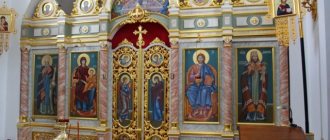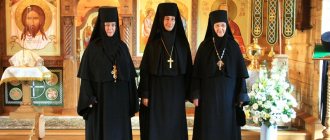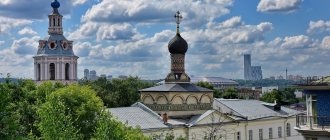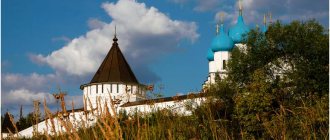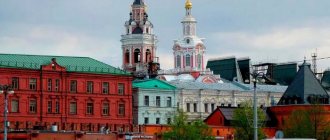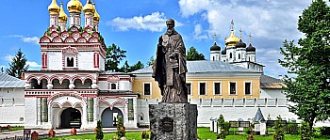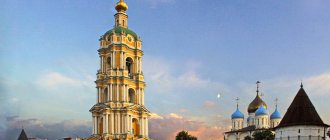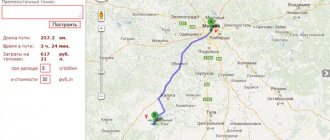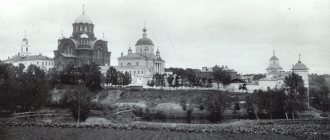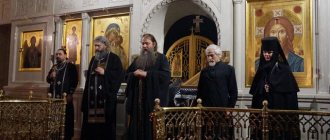Nikolsky Shostiensky stauropegial convent Stavropegial monasteries of the Russian Orthodox Church
From the moment of the creation of the Patriarchal Metochion, the priority task was the restoration of the temple and the resumption of divine services; Extensive repair and restoration work was carried out over 17 years.
The first service after a long break took place on Easter 2000. In 2003, a wooden church was built on the territory of the Patriarchal Compound in honor of the Dormition of the Blessed Virgin Mary.
In 2011, the blessing of His Holiness Patriarch Kirill of Moscow and All Rus' was received to create a structural unit “Service for Assistance to Family and Children” at the Patriarchal Metochion. Currently, twenty pupils aged from seven to seventeen live there.
On December 24, 2015, at the next meeting of the Holy Synod, a decision was made to transform the Patriarchal Metochion of the Church of St. Nicholas of Myra in the village of Shostye into the St. Nicholas Shostye Stavropegic Convent.
On May 7, 2021, on the 4th Sunday after Easter, about the paralytic, His Holiness Patriarch Kirill of Moscow and All Rus' visited the monastery and performed the rite of great consecration of the St. Nicholas Church in connection with the completion of repair and restoration work, and led the service of the Divine Liturgy in the newly consecrated church.
Three Altars were consecrated: the central one in honor of the Ascension of the Lord, the right one in honor of St. Nicholas, the left one in honor of the Holy Martyrs Florus and Laurus.
At the small entrance, His Holiness Patriarch Kirill elevated nun Neonilla (Frolova) to the rank of abbess and handed her the abbot's staff. Nun Neonilla was appointed to the position of abbess of the St. Nicholas Shostien Monastery by decision of the Holy Synod of December 24, 2015 (magazine No. 115).
Now more than thirty nuns, led by the abbess, Abbess Neonilla (Frolova), permanently reside in the monastery. The sisters perform obedience in the church, bake prosphora, work in the icon-painting, gold-embroidery and sewing workshops, in the refectory, in the dairy shop, barnyard, in the garden and vegetable garden, bake bread, work with children and the population. The monastery operates a Sunday school, an Orthodox kindergarten, and a youth history lecture hall; three sisters serve as teachers at the Szostien Secondary School.
In the monastery, a full circle of daily worship is performed every day, the Inexhaustible Psalter is read, akathists to St. Nicholas and the revered icons of the Mother of God “Assumption” and “Iverskaya”.
Holy Vvedensky Tolga Convent Official website
What time is the monastery area open to the public?
From 6:00 to 20:00.
When does the cedar grove open?
Kedrovnik opens once a year - on August 21. After the Liturgy, a prayer service is served in the cedar forest, then those who wish can visit this place.
Is it possible to come to live and work in the monastery and on what dates?
Pilgrimage and labor in the monastery are welcome. Tolga is always happy to help and guests. With the exception of a few days a year (Christmas, Easter, Tolgin Day...) there are no difficulties with accommodating pilgrims in hotels. Having arrived, you need to contact the sister on duty at the central entrance to the monastery (at the checkpoint), she will connect you with the hotel sister, and she, in turn, will accommodate you and assign obedience. You must have your passport with you. It is also advisable to bring with you work clothes and shoes suitable for work in the monastery. More detailed information can be found by calling 8 (962) 214–81–87 (for those who want to work hard) or 8 (910) 821–80–47 (for those who want to stay at a hotel for a donation). Additional information about the accommodation of pilgrims in the Tolga Monastery can be found here:
Are the sacraments of Wedding and Baptism performed in the monastery?
The sacraments of Wedding and Baptism are traditionally not performed in monasteries. To perform these sacraments, it is better to contact parish churches. They are baptized and married at the courtyard of the Tolga Monastery in the village of Vvedenskoye, Nekrasovsky district. You can discuss all the details by driving up to the courtyard church for the All-Night Vigil on Saturday evening or for the Liturgy on Sunday morning.
Is it possible to arrange a wedding photo shoot on the territory of the monastery?
Wedding photo shoots on the territory of the monastery are strictly prohibited. Newlyweds can come and pray at the miraculous icon of the Mother of God, but video or photo shooting is not allowed.
I want to become a monk, how can I enter your monastery? Are there any obstacles?
If we talk about obstacles, then, first of all, of course, a person who is connected by family ties and has small children cannot enter a monastery. Sometimes old age is an obstacle on the path to monastic life, when bodily infirmities and ingrained habits prevent one from completely changing one’s life. According to the teachings of the holy fathers, youth is more capable of monasticism than old age, for the young soul is flexible and more easily changes for the better. However, those who are older in years, but have retained the flexibility of their souls and are capable of monasticism, are, of course, accepted into the monastery. If there are no such obstacles, if a person has a firm intention to renounce the world, of course, nothing can prevent him from entering the monastery. We must also remember that people do not go to the monastery because of unhappy love or failures in life. A monk is a person who has left everything for the sake of living according to the Gospel, for the sake of saving the soul in eternity and love for God. If you decide to enter a monastery, we advise you to read spiritual literature about monasticism, for example, “An Offering to Modern Monasticism” by St. Ignatius (Brianchaninov). This book will introduce you to monasticism, the narrow path leading to eternal life. To test the firmness of your intention, it is better to live as a pilgrim in our monastery for some time. By getting acquainted with the internal structure of the monastery, the life of the sisters, and talking with the abbess or older sisters, you will be able to understand whether the monastic path corresponds to your spiritual structure. In any case, in addition to your personal desire, in order for you to remain in the monastery (not to mention taking monastic vows), you need the blessing of Mother Abbess. Therefore, the first step for you will be to come to the monastery as a pilgrim.
What time does morning/evening service start?
The weekly schedule of services is posted on the monastery website. Information can be found in this section: or in the news feed.
Is there a food station on the territory of the monastery?
Pilgrims and workers are provided with two free meals a day at the pilgrimage refectory. Guests of the monastery can visit the monastery meal “Arkhondarik”, where there is always a large selection of first and second courses, salads, pastries, hot and cold drinks, and various monastic products, which can be purchased for a small donation. Opening hours of "Arkhondarik": weekdays - from 8:30 to 18:00, Saturday - from 8:30 to 19:00, Sunday and holidays - from 9:30 to 19:00.
How many sisters are there in the monastery?
There are currently about 130 nuns in the monastery.
Are excursions organized?
You can take a tour of the monastery. They are conducted by the nuns of the monastery. The excursion can be booked at the entrance to the monastery (at the entrance), but it is advisable to book it in advance by calling 8 (910) 815-12-81.
How can I order my requirements from you?
Information about ordering memorials can be found here:
How to behave when visiting a monastery?
The monastery is a closed religious organization, and the time of visiting it is limited by the internal routine of the monastery. Visitors must have respect for the monastery and not allow a careless, disrespectful attitude towards the sisters and workers of the monastery. You should come to the monastery wearing modest, non-seductive clothing, without inappropriate inscriptions or images on it. Women should have their heads covered and their faces bare. Clothes should have long sleeves, and the skirt or dress should be of a decent length. It is not appropriate for a Christian woman to wear men's clothing (trousers), and for men to wear shorts. If necessary, upon entering the monastery, women can receive a scarf and skirt, which must be returned after the excursion. However, it is better for guests of the monastery to take care of the appearance in advance and on their own. A Christian should always wear a cross. When entering the temple, you need to be baptized. Men should remove their hats. You cannot engage in idle conversations with the inhabitants of the monastery. It is prohibited: shouting, talking loudly and laughing, smoking, using intoxicating or narcotic substances, drinking alcohol, being drunk, using loud-speaking equipment, playing musical instruments, singing, turning on radios, tape recorders, using obscene language, having obscene conversations, making noise or in any way interfering with services, spitting and littering on the territory of the monastery, entering the territory of the monastery with animals, having picnics, filming the sisters of the monastery, as well as filming inside churches during services is only possible with the blessing of the abbess of the monastery. If among the pilgrims there are those who wish to pray, submit memorial notes and light candles in front of the icons, then this must be done without disturbing those praying or creating fuss during the service. It is not permissible to behave disrespectfully and violate the prescribed rules of behavior. Entry into the residential and business premises of the monastery is prohibited. It is appropriate to turn off mobile phones before entering churches, as well as during the entire time you are escorted around the monastery.
How should workers behave during obediences and in their cells?
The monastery is a special world. And it takes time to learn the rules of monastic life. When you come to the monastery as a pilgrim or worker, remember that in the monastery they ask for a blessing for everything and strictly fulfill it. A monastery is a monastery in which monks live, people who have retired from worldly society, who have dedicated themselves to the feats of fasting and prayer, and who have taken vows of chastity, obedience and non-covetousness. This is a place where the name of God is glorified; it is appropriate to behave accordingly. We must behave as modestly, quietly, and attentively as possible, striving for the monastery to influence us, and not we to influence it. Many people lately are increasingly drawn to monasteries - these hospitals for the soul, which are distinguished by stricter discipline and longer services than parish churches. Some come here as a pilgrim, others as workers, to work on restoring the monasteries and strengthen their faith. A person who finds himself among the sisters of a monastery for some time, in one way or another, “fits himself in” to monastic life and tries to be more pious. But it should be remembered that with real contact with monastic life, passions and sinful inclinations, which for the time being dormant in the depths of the soul, become aggravated and come out. To avoid many temptations and problems, you need to adjust yourself to the fact that nothing is done in the monastery without a blessing, no matter how reasonable and justified your desire to do this or that thing may seem. In a monastery you must cut off your will and be completely subordinate to the sister who is responsible for the obedience to which you have been assigned. Naturally, those who come to the monastery must give up smoking, foul language and other sinful habits. Talk about worldly affairs, free speech, excessive and loud laughter are inappropriate here. When meeting, the layman is the first to bow to the monastic priest. When meeting in a monastery, they usually greet each other with bows and mutual greetings “bless you”, sometimes they say: “Save yourself, sister (brother).” It is customary to answer: “Save, Lord.” If any misunderstandings arise during obediences, there is no need to strive to “restorate justice,” much less lecture someone. It is necessary to help the weak, to cover with love the mistakes of the inexperienced, to endure insults with humility if they arise, when the common cause suffers, to turn to the assigned sister for resolution of the misunderstanding. The monastery is not a place for walking, swimming, or sunbathing. Here you are not only prohibited from exposing your body, but also from doing anything for self-pleasure. You can go outside the monastery only with a blessing. It is not customary in the monastery to go “to visit” - that is, to other people’s cells, except for obedience. When entering a cell, workshop or other monastic premises, a prayer is said aloud: “Through the prayers of the saints, our fathers, Lord Jesus Christ our God, have mercy on us.” You are allowed to enter only if you hear from behind the door: “Amen.” For spiritual questions of interest, you can contact priests. They leave all their sinful habits and addictions (wine, tobacco, foul language, etc.) outside the monastery. Conversations are only about spiritual things, they do not remember about worldly life, they do not teach each other, but they know only two words - “forgive” and “bless”. Without grumbling, they are content with food, clothing, and sleeping conditions. When working on obediences, they say a prayer, try to spare the weak person who works nearby, covering with love the errors in his work. Insults encountered during general obediences are endured humbly, thereby gaining experience in spiritual life and love for others.
Story
Derman was first mentioned in 1497 as a possession granted to Prince Konstantin Ivanovich Ostrozhsky. Oct 11 In 1499, he placed “in the Church of the Holy and Life-Giving Trinity of the honorable monastery of Derman” a manuscript of the teachings of the Patriarch of Constantinople, St. Callista (†XIV) with a dedicatory inscription (it is the earliest news about the monastery); in 1507, the prince presented the monastery with a handwritten Gospel, where a record of this event was made in someone else’s hand on behalf of Konstantin Ivanovich; in 1538, Daniil Elovitsky donated a handwritten “Apostle” to the “monastery of the Great Lavra in Dermani”.
In 1575-1580 The affairs of the monastery were managed, as a manager, by the Russian pioneer printer Ivan Fedorov: having moved from Moscow to Zabludov (then in Lithuania, now in Poland), and then to Lvov, he was invited to the Ostrogsky estates by Prince Vasily-Konstantin (son of Konstantin Ivanovich) . Seeing the difficult situation of the Orthodox in the Catholic Polish-Lithuanian Commonwealth, Vasily-Konstantin cared about church learning, which would help defend the truth before those of other faiths, and therefore attracted the best Orthodox scribes of his time (in 1580-1581, the prince, together with Fedorov, published 1 -th complete printed Church Slavonic Bible).
In 1602, the prince confirmed for the monastery all the lands granted to it and ordered the monks to live according to the communal rules: “We give our Dermansky monastery with ... all its accessories for the common life of the monks”; “The monastery, which is called konovia (dormitory), in our time ... was given (to the monks), laid and founded” (by laying is meant stone construction, see below). The cited charter of Vasily-Kontantin also prescribed to accept into the monastery “only those who would like to obey that order (the communal order) and who would strive for science.” The prince also gave printing presses to the monks, as stated in the preface of the first book published in Dermani - “Octoeha” 1603-1604. The Derman printing house was headed by priest Damian Nalivaiko - confessor of Vasily-Constantine, rector of the Epiphany Cathedral in Ostrog, writer, brother of Severin Nalivaiko (leader of the uprising in Ukraine in 1594-1596 against Poland). In 1602-1605. The abbot of the monastery was Abbot Isaac Boriskovich, who had previously lived on Mount Athos and received the title of protosynkel (secretary) of the Patriarch of Alexandria, and ended his earthly journey as Bishop of Lutsk (†1643). Together with Fr. John of Boretsky, the future Metropolitan of Kiev Job (†1631), and St. John of Boretsky worked as Isaac and Damian in Dermani. Job Knyaginitsky is an ascetic of Athos and the future founder of the Manyavsky Skete in Galicia (†1621). In 1605, the printing house was moved to Ostrog (again after 1580), and all the workers listed above went to other places of service. In 1608, Vasily-Constantine entrusted the monastery to the exarch of the Patriarch of Constantinople, Abbot Isaiah Balaban, and subordinated all the monasteries in his estates to him.
Later, Derman ended up in the possession of the Catholic prince Alexander Zaslavsky. In 1627, Archbishop turned to him, asking for a monastery to manage. Polotsk Meletiy Smotritsky. In response, the prince demanded that the petitioner join the union. A famous writer-theologian of his time, Bishop Meletius, like many of his compatriots, painfully sought a peaceful way out of the conflict between the oppressed Orthodox citizens of the Polish-Lithuanian Commonwealth and the Catholic authorities of the country. But due to the fact that Smotritsky’s upbringing in childhood was in the spirit of Orthodoxy, and in his youth - under the influence of Catholicism, this talented and learned hierarch constantly wavered in his views. As a result, he never developed strong convictions. Zaslavsky’s condition was accepted (with the proviso that Meletius’s Uniatism would be temporarily kept secret). According to one of Smotritsky’s biographers, the Dermansky monastery attracted Meletius because, with frequent forced wanderings, it “freed the writer from the life that burdened him “on someone else’s bread.” In 1628, Smotrytsky openly recognized himself as a Uniate; in 1633 he rested in the Derman monastery, where he was buried.
In con. 1st half XVII century in the monastery, a “Commemoration Book” was compiled, where against the name of the “confessor” (spiritual father) Hieromonk Abraham (the phrase indicates the author and the time, not earlier than which the “Commemoration Book” appeared). The last entry with a date, made in the “Commemoration Book” by the hand of Fr. Abrahamia, dates back to 1644 (in 1663 another entry was made in a different handwriting). The book mentions “Vasily K(onstantin) K(onstantinovich), K(nyaz) Ostroz(ky), who walled the church and belfry, and was himself at the foundation, and the founder of the entire Dermansky monastery. Resigned to fate from the creation of the world 6961, from the Nativity of Christ 1608.” However, the named year “from creation” does not correspond to 1608 AD. (when Vasily-Konstantin actually died), and 1453 - in the era of Vasily Fedorovich Ostrozhsky, nicknamed Red (great-grandfather of Vasily-Konstantin): probably, during the years of writing the “Commemoration” there was a legend about the founding of the monastery of V.F. Ostrozhsky, and Fr. Abraham mixed two princes into one person.
Despite Smotrytsky’s act, the union, according to historians, was established in the monastery later - under the abbot Iannuariy Ogurtsevich (1712-1729), who in 1720 took part in the Uniate cathedral in Zamosc. In 1766, Abbot Melchizedek Znachko-Yavorsky, the abbot of the Matroninsky monastery in Cherkasy region, was temporarily detained in the monastery for his active work in defense of the Orthodox (in the same year, Father Melchizedek was helped to escape from Dermani to another part of Ukraine, which was under the protectorate of Russia ).
In con. XVIII century Derman became part of the Russian Empire, and in 1822 the monastery was returned to the Orthodox. Since 1833, 2 theological schools operated under him: a district and a parish (in 1854 they were united, in 1877 the district school was transferred to Klevan). In 1845-1873 the monastery was home to the suffragan bishops of the Volyn diocese, who bore the title “Ostrogsky”. In 1944, the monastery became a convent, in 1960 it was closed and allocated for a special boarding school, and in 1991 it was revived.
